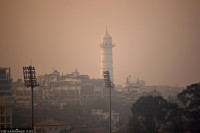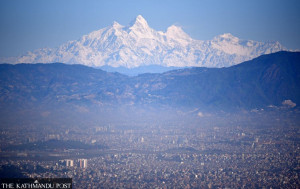Climate & Environment
Met office forecasts above-average rainfall from December to February
Experts say above-average rainfall helps for a good harvest of winter crops. Nepal witnesses 61 mm rainfall on average in the dry season.
Post Report
Nepal is likely to witness above-average rainfall in the ongoing winter season, between December and February, according to a forecast by the Department of Hydrology and Meteorology.
The department’s climate section, which issued the forecast, says there is a chance of above-average rainfall in most parts of the country during the period between December 1, 2023 and February 29, 2024.
There is 55 to 65 percent chance of above-average rainfall in north-east parts of Sudurpaschim Province and northern parts of Karnali Province, the report says. There is 45 to 55 percent chance of above-average rainfall in the said period in eastern and southern parts of Sudurpaschim Province, southern parts of Karnali Province, all parts of Lumbini Province except eastern parts, Gandaki Province, north-west parts of Bagmati Province, north-east parts of Koshi Province.
The met department said that there is a 35 to 45 percent chance of above-average rainfall in western parts of Sudurpaschim Province, eastern parts of Lumbini Province, central and southern parts of Bagmati Province, western parts of Madhesh Province and north-west parts of Koshi Province. However, there is a 35 to 45 percent chance of below-average rainfall in the southern parts of Koshi Province and central and eastern parts of Mahesh Province in the said period.
The department has also issued a forecast of the maximum temperature: there is a 45 to 55 percent chance of above-average maximum temperature in southern parts of Gandaki Province, western parts of Bagmati province, eastern and western parts of Madhesh Province, and southern parts of Koshi Province.
Likewise, there is a 35 to 45 percent chance of above-average maximum temperature in southern parts of Sudurpaschim and Karnali Province, Lumbini Province, central and eastern parts of Bagmati Province, central parts of Madhesh Province, central and northern parts of Koshi Province.
Moreover, there is a 35 to 45 percent chance of average maximum temperature in the eastern and northern parts of Sudurpaschim Province.
The department has also forecasted the minimum temperature: there is a 45 to 55 percent chance of above-average minimum temperature in south-east parts of Karnali Province, north-west parts of Lumbini Province, southern parts of Gandaki Province, western parts of Bagmati and Madhesh Provinces, and southern parts of Koshi Province. The chance of above-average minimum temperature is 35 to 45 percent in Sudurpaschim Province, western parts of Karnali Province, southern parts of Lumbini Province, eastern parts of Bagmati and Madhesh Provinces, and central and northeast parts of Koshi Province. There is a 35 to 45 percent of the average minimum temperature in central-north parts of Karnali Province while the chance of below-average temperature in the rest of the parts of the province is 35 to 45 percent.
Nepal witnesses 61 mm rainfall on average in winter, according to Sudarshan Humagain, a meteorologist at the Department. “Prediction of 55 to 65 percent above-average rainfall’s chance means the probability of above-average rainfall is high,” he said.
Experts say above-average rainfall in the winter helps in boosting agriculture yield. It also helps in reducing air pollution in the country and helps in animal husbandry, among others.
The department’s prediction of rainfall in the post-monsoon season was largely correct.
Nepal has been on the receiving end of the worst effects of the climate crisis and witnessed multiple extreme weather events over the past decade and a half.
Evidence suggests that the maximum temperature in Nepal is rising faster, at 0.056 degrees Celsius a year, compared to the global average of 0.03 degrees.
Experts say extreme weather events—excessive rainfall in a short time, continuous rain for several days post-monsoon, dry spells and droughts, below-average precipitation and above-normal temperatures in winter—have become more frequent in Nepal in recent years.
Scores of studies and scientific analyses over the decade, and more recently, the IPCC report, have said that Nepal is one of the most vulnerable countries to climate change and it takes more than a business-as-usual approach to tackle the adverse impacts of the climate crisis.




 14.12°C Kathmandu
14.12°C Kathmandu










